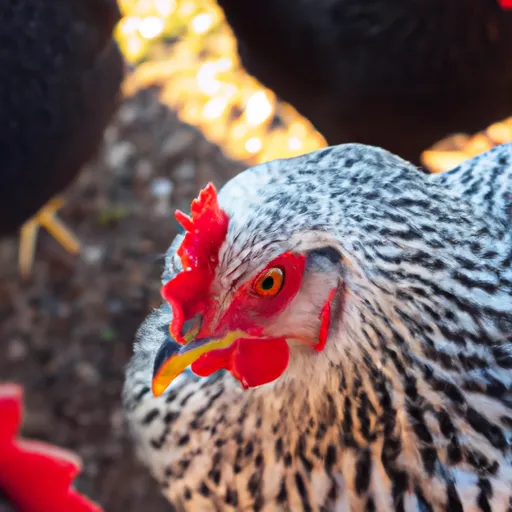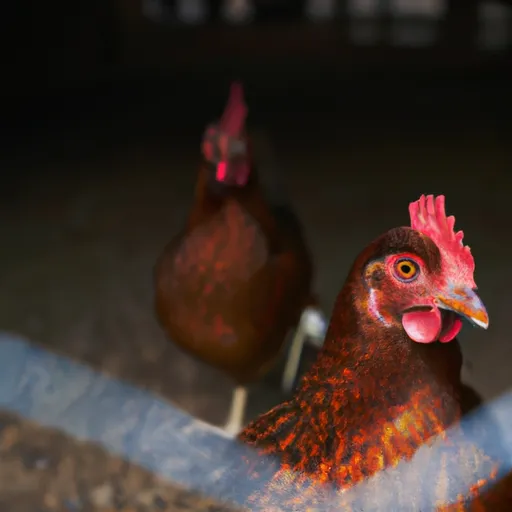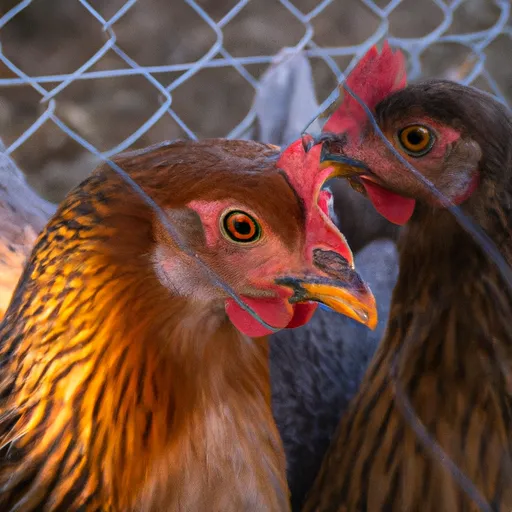The Majestic Beauty of Plymouth Rock Chicken
If you've ever wondered about the allure of Plymouth Rock chickens, let me tell you, their majestic beauty is undeniable.
With their striking barred patterns and regal stature, these birds are a delight to behold.
Whether it's the exquisite barred rock chicken eggs or the elegant plumage of the white Plymouth Rock chicken, there's something truly captivating about these creatures.
Join us as we explore the fascinating world of Plymouth Rock chickens and uncover why they continue to be a popular choice for poultry enthusiasts worldwide.
The History of Plymouth Rock Chicken
Origins of Plymouth Rock Chicken
The Plymouth Rock chicken, also known as the Barred Plymouth Rock or simply as the Plymouth chicken, is a breed that originated in the United States in the mid-1800s.
While its precise origins are not fully known, it is believed to have been developed in New England, specifically in the town of Plymouth, Massachusetts.
The breed is a cross between several European chicken breeds, including the Dominique and Black Java, which were brought to America by the early European settlers.
Introduction of Plymouth Rock Chicken to the United States
The Plymouth Rock chicken was officially recognized as a distinct breed in 1869 by the American Poultry Association.
Its popularity quickly grew not only among farmers but also among backyard chicken enthusiasts.
The breed was widely regarded for its versatility and suitability for both meat and egg production.
Its introduction to the United States marked the beginning of a new era for chicken farming and solidified the breed's place in American agricultural history.
Popularity and Spread of Plymouth Rock Chicken
The Plymouth Rock chicken gained widespread popularity across the United States due to its exceptional qualities. Its docile nature, adaptability to various climates, and impressive production capabilities made it a favorite among farmers and homesteaders.

The breed's distinctive barred feather pattern also contributed to its popularity, as it added visual appeal to backyard flocks.
Over time, the Plymouth Rock chicken spread beyond the United States and gained recognition internationally for its desirable traits, making it one of the most well-known and beloved chicken breeds today.
Physical Characteristics of Plymouth Rock Chicken
Size and Shape
The Plymouth Rock chicken is a medium-sized breed with a well-rounded body and a compact build.
It typically weighs between six to eight pounds for hens and eight to nine and a half pounds for roosters.
Their broad chest, stout legs, and moderately long back give them a robust appearance that reflects their dual-purpose abilities in both egg-laying and meat production.
Feathers and Coloring
One of the most distinctive features of the Plymouth Rock chicken is its striking barred feather pattern.
The feathers are characterized by alternating dark and light bars that cover the bird's body, with the head, neck, and tail feathers being predominantly black.
The coloration of the feathers gives the breed an elegant and sophisticated appearance
.
However, there are also other variations of the Plymouth Rock chicken, such as the white and buff varieties, which have solid-colored feathers.
Comb and Wattles
The Plymouth Rock chicken has a single comb, which is a prominent feature on top of its head.
The comb is typically red in color, and though it varies in size among individuals, it is usually medium-sized compared to other chicken breeds.
The wattles, which are fleshy lobes that hang down from the sides of the chicken's face, are also red and add to the breed's overall aesthetics.
Beak and Eyes
The beak of the Plymouth Rock chicken is strong and slightly curved, allowing the bird to efficiently peck at food and forage in various environments.
The eyes are typically reddish-brown and are alert and expressive, reflecting the breed's curious and intelligent nature.
Legs and Feet
The Plymouth Rock chicken boasts sturdy legs that are well-positioned and designed for both mobility and stability.
The legs are typically yellow, which complements the breed's black and white barred feathers.
The feet have four toes, with three toes facing forward and one toe facing backward, enabling the bird to easily perch and navigate various terrains.
This image is property of cdn.knowyourchickens.com.
Temperament and Behavior
Docile and Friendly Nature
Plymouth Rock chickens are known for their calm and friendly temperament, making them an ideal choice for both novice and experienced chicken keepers alike.
They are sociable and naturally curious, often approaching humans with ease and showing a remarkable level of friendliness.
This docile nature makes them excellent additions to family farms, where they can be enjoyed by people of all ages.
Ability to Adapt to Various Climates
A remarkable quality of Plymouth Rock chickens is their ability to adapt to different climates.
Whether it's cold winters or hot summers, these birds can withstand a wide range of temperatures.
This adaptability makes them suitable for chicken keepers in various regions, allowing them to thrive and continue to produce eggs and meat throughout the year.
Foraging and Roaming Characteristics
Plymouth Rock chickens have a natural instinct for foraging and are highly active birds.
They enjoy exploring and can be observed pecking at the ground, searching for insects and small plants to eat.
As a result, these chickens are often excellent foragers and can happily spend their time roaming around in a free-range environment, making them a great choice for those looking to integrate their flock into a natural and sustainable farming system.
Interaction with Humans and Other Animals
Due to their friendly and sociable nature, Plymouth Rock chickens are generally well-suited for interaction with humans.
They are not easily skittish or aggressive, which allows them to be easily handled, making tasks such as health inspections or egg collection stress-free.
Additionally, Plymouth Rock chickens tend to get along well with other chicken breeds and animals, which is important when keeping a mixed flock or introducing new poultry to an existing one.
Breeding and Reproduction
Mating Behavior
When it comes to breeding, Plymouth Rock chickens follow the standard behavior observed in most chicken breeds.
The roosters, also known as cocks, will engage in courtship displays, such as fluffing their feathers, puffing out their chests, and emitting low, rumbling sounds to attract the attention of the hens.
Once a pair has bonded, mating will occur.
Incubation Period
Once the hens have successfully mated, they will begin the process of incubation.
The incubation period for Plymouth Rock chicken eggs typically lasts approximately 21 days.
During this time, the hen will diligently sit on her eggs, keeping them warm and ensuring proper development inside the eggs.
Caring for Chicks
Once the chicks hatch, the mother hen or broody hen will continue to care for them, protecting and guiding them as they navigate the world.
Plymouth Rock hens are known for their strong maternal instincts and are highly attentive to their young.
They will teach the chicks how to forage, dustbathe, and interact with other members of the flock.
Plymouth Rock Chicken as Broody Hens
Plymouth Rock chickens are renowned for their inclination to go broody. Broodiness is a natural trait in hens that compels them to incubate a clutch of eggs and raise the resulting chicks.
This broody behavior has made Plymouth Rock hens valuable for smaller-scale breeders who prefer to hatch and raise chicks naturally, without relying on artificial incubators.
Plymouth Rock Chicken as a Dual-Purpose Breed
Egg Production
The Plymouth Rock chicken is widely regarded as an exceptional egg producer. Hens of this breed are known for their ability to lay a consistent supply of large brown eggs throughout the year.
On average, a Plymouth Rock hen can lay around 200 to 280 eggs annually, making them an invaluable addition to backyard flocks or small-scale egg production operations.
Meat Quality
In addition to their egg production capabilities, Plymouth Rock chickens are also highly regarded for their meat quality.
The breed possesses well-developed muscles, which contribute to its excellent meat yield and flavor. The meat of Plymouth Rock chickens is known for its tenderness and juiciness, making it a popular choice amongst those seeking both quantity and quality in their poultry products.
Suitability for Homesteaders and Backyard Farmers
The Plymouth Rock chicken's dual-purpose qualities make it an ideal breed for homesteaders and backyard farmers.
Its ability to provide a steady supply of both eggs and meat meets the self-sufficiency aspirations of many individuals.
Additionally, their docile nature, adaptability to various climates, and overall hardiness make them a reliable choice for those seeking a low-maintenance and rewarding chicken-keeping experience.
Health and Care
Common Health Issues
While the Plymouth Rock chicken is generally a hardy breed, it is still susceptible to certain health issues.

One common health concern is parasitic infestations, including mites and lice, which can cause discomfort and affect the bird's overall health.
Another issue to watch out for is respiratory diseases, such as infectious bronchitis or Newcastle disease.
Regular health checks, proper nutrition, and clean living conditions are essential in preventing and managing these health issues.
Recommended Care and Maintenance
To ensure the well-being of Plymouth Rock chickens, providing them with appropriate care and maintenance is crucial.
Regular cleaning of the coop, including the removal of droppings and debris, helps prevent disease and maintains the overall hygiene of the living environment.
Additionally, ensuring access to fresh food and water, as well as providing appropriate dustbathing areas and perches, will contribute to the birds' overall health and well-being.
Feeding and Nutrition Guidelines
To meet the nutritional needs of Plymouth Rock chickens, a balanced diet is essential.
A quality commercial chicken feed should form the basis of their diet, supplemented with fresh vegetables, fruits, and grains.
Additionally, offering supplemental calcium, such as crushed oyster shells, ensures strong eggshells.
It is important to provide a sufficient quantity of food and fresh water daily, taking into account the number of chickens and their stage of development.
Providing Shelter and Space
Plymouth Rock chickens require suitable shelter and adequate space for their well-being. The coop should be secure, providing protection from predators and the elements.
It should also have proper ventilation to prevent the buildup of moisture and ammonia fumes. Each hen requires a minimum of four square feet of floor space, with additional space necessary for roosters and other flock members.
Outdoor access, such as a fenced yard or free-range area, allows the chickens to engage in natural behaviors and obtain essential sunlight and fresh air.
Tips for Raising Plymouth Rock Chickens
Choosing the Right Breeders
When acquiring Plymouth Rock chicks or adult birds, it is essential to source them from reputable breeders.
Look for breeders who prioritize health, temperament, and adherence to breed standards.
Visiting the breeder's facility or contacting them for information can help ensure that you are bringing home healthy and well-cared-for chickens.
Setting Up the Coop
Carefully plan and set up the chicken coop to cater to the specific needs of Plymouth Rock chickens. Ensure that it is spacious, well-ventilated, and secure from predators.
Consider the placement of nesting boxes, roosting perches, and feeding and watering stations for easy access and efficient care.
Feeding and Watering Practices
Provide a balanced diet by offering high-quality commercial feed specifically formulated for chickens.
Supplement their diet with fresh fruits, vegetables, and grains to enhance their overall nutrition. Ensure a constant supply of clean water, as chickens require an ample amount for digestion, egg production, and overall health.
Handling and Socializing
Regular and gentle handling of Plymouth Rock chickens from a young age helps establish trust and reduce fear or aggression.
Develop positive interactions by talking softly to the chickens, hand-feeding treats, and slowly spending time near them.
This encourages a friendly, sociable demeanor and minimizes stress during health checks or necessary interventions.
Ensuring Safety and Security
The safety and security of Plymouth Rock chickens are paramount. Regularly inspect and reinforce the coop's structure, ensuring there are no gaps or holes for predators to enter. Use sturdy hardware cloth to secure the windows and openings.
Additionally, provide a secure fence or use electric fencing to prevent predators from gaining access to the outdoor area.
Famous Examples of Plymouth Rock Chicken
White House Flock
The White House has a long history of keeping a diverse array of poultry, including Plymouth Rock chickens.
Numerous presidents, including Abraham Lincoln and Franklin D. Roosevelt, have maintained flocks of Plymouth Rock chickens on the White House grounds.
These flocks not only provided a sustainable source of eggs and meat but were also a symbol of self-sufficiency and the agricultural heritage of the United States.
Champion Show Birds
Plymouth Rock chickens have a rich tradition in the show ring. Their distinctive barred feather pattern, combined with their overall excellence in form and breed characteristics, has made them frequent contenders at poultry shows around the world.
Many champion Plymouth Rock chickens have secured prestigious titles and awards, further cementing the breed's reputation for its outstanding qualities.
Records and Achievements
Over the years, Plymouth Rock chickens have achieved notable records in the realm of egg production.
Many individual birds of this breed have managed to lay exceptional quantities of eggs within a specific time period.
These achievements display the breed's remarkable productivity and demonstrate the potential for outstanding performance when the chickens are well-cared for and provided with optimal conditions.
Plymouth Rock Chicken in Popular Culture
Depictions in Literature and Art
The Plymouth Rock chicken has not only made its mark in agriculture but has also left a lasting impression in popular culture, particularly in literature and art.
The breed has been featured in various children's books, where its striking appearance and friendly nature often play a central role.
Also, its distinctive barred feather pattern has made it a favorite subject for artists who seek to capture the beauty and elegance of poultry.
Role in Farming and Agricultural Communities
Plymouth Rock chickens hold a significant place in farming and agricultural communities.
They serve as a symbol of traditional farming practices and the self-sufficiency that many individuals strive to achieve.
The breed's reliability, versatility, and exceptional qualities have made it a beloved choice among farmers, homesteaders, and backyard chicken enthusiasts.
Plymouth Rock chickens continue to play a vital role in sustainable farming and the preservation of heritage breeds.
Conclusion
Appreciating the Beauty and Utility of Plymouth Rock Chicken
The Plymouth Rock chicken stands as a testament to the rich history of American poultry farming.

Its origins date back to the earliest days of the United States and reflect the ingenuity and resourcefulness of the early settlers.
With its striking barred feather pattern, docile temperament, and remarkable production capabilities, the Plymouth Rock chicken has become a favorite among chicken keepers worldwide.
Beyond its aesthetic appeal, the breed's dual-purpose nature, combining excellent egg-laying capabilities with high-quality meat production, makes it an ideal choice for homesteaders and backyard farmers alike.
Its adaptability to various climates, friendly temperament, and strong maternal instincts further contribute to its appeal and suitability for sustainable and responsible chicken-keeping practices.
From the White House to champion show rings, the Plymouth Rock chicken has etched its name in both agricultural history and popular culture. Its presence in literature, art, and agricultural communities serves as a reminder of the breed's enduring significance and impact.
As we appreciate the beauty and utility of the Plymouth Rock chicken, it is essential to recognize the importance of preserving and promoting heritage breeds like this.
By supporting and raising Plymouth Rock chickens and other heritage breeds, we contribute to sustainable farming practices and the conservation of genetic diversity within the poultry world.
